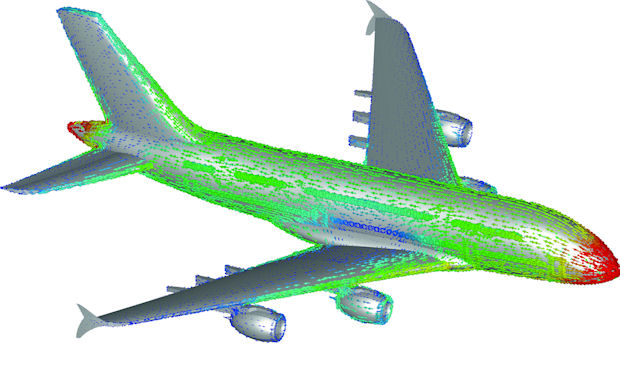Editor’s Pick: Software Analyzes Electromagnetic Compatibility and Interference

Engineers can use CST EMC STUDIO to analyze designs for electromagnetic compatibility and electromagnetic interference in such applications as aerospace, printed electronics and telecommunications. Image courtesy of Computer Simulation Technology AG.
Latest News
February 18, 2015
 Dear Desktop Engineering Reader:
Dear Desktop Engineering Reader:
 ’Twas the night before Valentine’s Day, and I in my cap had just settled with my e-reader before a long winter’s nap. When from my bedside, there arose a brief burst of white noise, and I turned to see what was the matter. ’Twas gone, so I returned to my reading. Then it happened again. And again. I finally figured out that I had bumped the ancient clock radio into its portable music device setting and that every time I swiped a new page on the e-reader, the radio picked up the low-level electronic signals of a page turning. Fascinating, and thankfully, harmless.
’Twas the night before Valentine’s Day, and I in my cap had just settled with my e-reader before a long winter’s nap. When from my bedside, there arose a brief burst of white noise, and I turned to see what was the matter. ’Twas gone, so I returned to my reading. Then it happened again. And again. I finally figured out that I had bumped the ancient clock radio into its portable music device setting and that every time I swiped a new page on the e-reader, the radio picked up the low-level electronic signals of a page turning. Fascinating, and thankfully, harmless.
Electromagnetic interference (EMI) and its complement, electromagnetic compatibility (EMC), are big concerns across all sorts of industries like aerospace, automotive, consumer electronics, defense and telecommunications because EMI can be anything but harmless if not accounted for properly. So it was interesting when a new product release came in the other day from Computer Simulation Technology (CST), the developer of a range of software for simulating electromagnetic fields. This is a good one.
The short of it is that the company’s new CST EMC STUDIO software provides you with a toolkit of solver technologies for studying the effects of EMC, including radiated or conducted emissions and susceptibility to electrostatic discharge, lightning strikes and high-intensity radiated fields. The software’s solvers and tools are based on those used in the company’s CST STUDIO SUITE, probably CST’s best known application for electromagnetic simulation, as well as its CST BOARDCHECK program for EMC and signal integrity rule checking.
CST EMC STUDIO offers general-purpose 3D modules for time and frequency domain simulation as well as specialized solvers, including a 3D transmission line matrix (TLM) method solver. The TLM solver is designed to help simplify your numerical EMC analysis by using octree meshing to reduce simulation time on complex structures. The software’s bidirectional cable/field simulation enables more realistic modeling of noise propagation and radiation over cables, and its true transient EM/circuit capabilities can help you analyze the effect of nonlinear circuitry on EMC performance. The TLM method solver also supports compact model representations of fine details.
Some of the other tools you’ll find in CST EMC STUDIO include a cable harness solver, rule checking and compact models for simulating vents and seams. The cable harness solver offers bidirectional coupling for time domain solvers. This coupling, says the company, lets you integrate cable harnesses into a 3D model and analyze them using bidirectional simulation.
CST EMC STUDIO’s rule checker is designed to help you analyze imported PCB (printed circuit board) layouts against a set of design rules quickly. It highlights anything that breaks a rule and could lead to EMC problems. Speaking of imported files, CST EMC STUDIO’s EDA (electronic design automation) and CAD import tools support files from leading toolsets like Xpedition from Mentor Graphics and CR8000 from Zuken in addition to ODB++ databases.
For those of you who use CST DESIGN STUDIO, you’ll find that it increases the capabilities of CST EMC STUDIO’s 3D solvers with circuit simulation. For example, you can include nonlinear circuit elements in a 3D simulation using what the company describes as true transient/circuit co-simulation. CST DESIGN STUDIO also lets you link models through CST’s System Assembly and Modeling simulation project management environment. This will let you run simulations of hybrid systems made up of individual components.
All in all, the press release may have been brief, but CST EMC STUDIO sounds like big stuff. You can learn more about it without any more interference from me by hitting the link to today’s Pick of the Week write-up.
Thanks, Pal. — Lockwood
Anthony J. Lockwood
Editor at Large, Desktop Engineering
Read today’s pick of the week write-up.
This is sponsored content. Click here to see how it works.
Subscribe to our FREE magazine, FREE email newsletters or both!
Latest News
About the Author
Anthony J. Lockwood is Digital Engineering’s founding editor. He is now retired. Contact him via [email protected].
Follow DE





